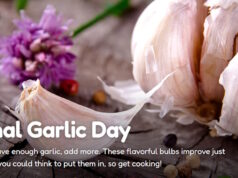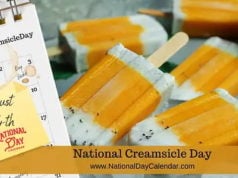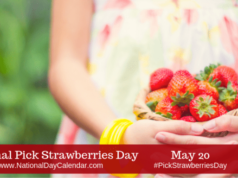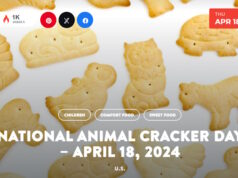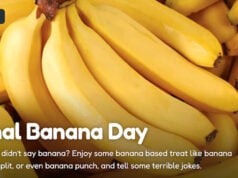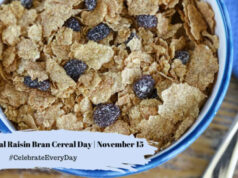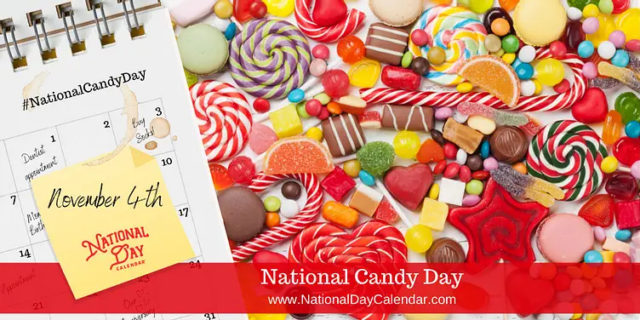
Updated February 20, 2024
On November 4th we celebrate the sweet holiday, National Candy Day. Candies have a long history of attracting us with their bright colors and delightful flavors. They also come in a variety of fun sizes and shapes.
- In the late 13th century, Middle English first began using the word candy. Borrowed from the Old French cucre candi, it is derived in turn from Persian Qand and Qandi, cane sugar.
- By the 18th century, the first candy likely came from Britain and France to America. At the time, people made the simplest form of candy from crystallized sugar – rock candy. However, even the most basic form of sugar was considered a luxury and was only attainable by the wealthy.
- The first chocolate eggs were made in Europe in the early 19th century and remain among the most popular treats associated with Easter.
- 1817 – In a town in Yorkshire, England, Samuel Parkinson began making butterscotch as a hard candy.
- By the 1830s, markets opened and the candy business underwent a drastic change. Not only did the price of candy drop, but penny candies targeted children.
- 1847 – The invention of the candy press made it possible to produce multiple shapes and sizes of candy at one time.
- 1851 – Confectioners begin using a revolving steam pan to assist in boiling sugar.
- 1883 – David Bradley’s candy store in New Jersey flooded due to a major storm, resulting in him calling his taffy “saltwater taffy.”
- 1896 – Tootsie Rolls debuted in 1896, introduced by Leo Hirshfield of New York who named them after his daughter’s nickname, “Tootsie”.
- 1960 – Starburst candies were invented in the UK by Peter Phillips.
- Since 1979, the world has produced more sugar than can be sold, making it very attainable and cheap.
- Sugar wasn’t always readily available, so the first candies were made from honey. Candy makers coated coat fruits and flowers with honey. This method preserved the flowers and nuts or created forms of candy.
- Originally a form of medicine, candy calmed the digestive system or cooled a sore throat. At that time, combined with spices and sugar, candy only appeared in the purses and the dishes of the wealthy.
- The two top-selling candies in America have been:
- M & M’S — M&M’s are milk chocolate drops with a colorful candy coating on the outside. Forrest Mars, Sr. and William Murrie developed M&M’s following the Spanish Civil War. They dubbed the new candy with the initials of their surnames. The candies debuted in 1941 and were given to American soldiers serving in the Second World War.
- Reese’s Peanut Butter Cups — Reese’s Peanut Butter Cups are round chocolate disks that are filled with a sweet, creamy peanut butter filling. Hershey’s company first manufactured the iconic cups in 1928.
- The winter holidays represent the biggest boxed chocolate selling season.
- How many licks does it take to get to the center of a tootsie-pop? According to student researchers at Purdue, it’s 364 licks.
- Until the 1930s, the Sugar Daddy candy pop was called the “Papa Sucker.”
- The name “Pez” comes from the German word “pfeffErminZ,” meaning “peppermint.”
- Americans purchase nearly 600 million pounds of candy a year for Halloween.
- An incredible 90 million pounds of chocolate candy is sold during Halloween week, taking a strong lead compared to other holidays. Almost 65 million pounds is sold during the week leading up to Easter and only 48 million pounds during Valentine’s week.
- Over 10% of annual candy sales happen the days leading up to Halloween — that is nearly $2 billion dollars in sales.
- Chocolate is clearly the preferred choice of sweets for many. Of the $1.9 billion sold in Halloween candy each year, $1.2 billion was on chocolate candy and only $680 million on sugar candy.
- More than 35 million pounds of candy corn will be produced this year. That equates to nearly 9 billion pieces — enough to circle the moon nearly four times if laid end-to-end.
- Candy Corn is the most searched-for candy term in Google — more popular than candy apples, gummy worms and candy pumpkins.
- The day of the year with the most candy sales? October 28th. And of all the 365 days in the year, the top five candy selling days are all in October.
- The average American household spends $44 a year on Halloween candy!
- Germans consume twice as much candy as Americans.
- 65% of American candy bars were introduced more than 50 years ago
- Gummy worms were introduced on July 15, 1981, the 50th anniversary of gummy bears.
- A one-ounce piece of milk chocolate contains about the same amount of caffeine as a cup of decaffeinated coffee.
- Tootsie Rolls, according to the official recipe, the previous day’s Tootsie Roll batch is mixed into the new batch each day, so theoretically, this means there’s a tiny amount of the very first Tootsie Rolls in every new roll made today.
- Tootsie Rolls were added to soldiers’ rations during World War II due to their durability in all weather conditions.
- Every day, 64 million Tootsie Rolls are made. That’s over 44,440 Tootsie Rolls per minute.
- M&Ms plain Chocolate Candies were introduced in 1941 in response to slack chocolate sales in summer.
- 200 million Skittles are produced each day.
- Americans over 18 years of age consume 65 percent of the candy which is produced each year.
- The ancient Aztecs believed that chocolate was an aphrodisiac. Chocolate contains phenyl ethylamine (PEA), a natural substance that is said to stimulate the same reaction in the body as falling in love.
- During the 1849 Gold Rush, Dombringo Ghirardelli from Italy began making chocolate in San Francisco. His factory still stands at Ghirardelli Square.
- 2.8 billion pounds of chocolate is consumed in America each year, which is over 11 pounds per person.
- The U.S. produces more chocolate than any other country in the world but the Swiss consume the most, followed closely by the United Kingdom.
- The melting point of cocoa butter is just below the body temperature, which is why chocolate melts when you put it in your mouth.
- Americans eat 25 pounds of candy, per person, per year. The people of Denmark eat more than 36 pounds of candy per person, per year.
- During Ronald Reagan’s 1981 inauguration, Jelly Belly served more than 3 tons of jelly beans!
- President Nixon regularly had the breakfast of champions, Milky Way! Supposedly, the president had a sweet tooth and loved Milky Way bars.
- In 1949, Bill and Dorothy Harmsen founded the Jolly Rancher company. Getting its start in Golden, Colorado, the company sold ice cream, candy, and chocolate at local stores. The fun fact here comes in the name. Since these tasty hard candies were created in the west, Bill wanted them to represent the spirit of the people. The name, “Jolly Rancher,” was chosen to connote a “hospitable western company.”
- All Hershey’s Kisses have a white paper strip that comes out of the top of the wrapper. But do you know what it’s called? This little flag is actually called a “plume.” Hershey’s originally introduced it to distinguish itself from phony knock-off candies.
- Back in 1953, when Peeps were first put into production, it took 1,620 minutes to make one. Now, it only takes six minutes from start to finish to make one Peep! Good thing, because every day, factories make 5.5 million Peeps to keep mouths fed and sweet teeth happy!
- In 1847, the invention of the candy press made it possible to produce multiple shapes and sizes of candy at once.
- Rock candy was a happy accident of a Scottish hard candy maker. A Dutch man invented the first hard chocolate candy in 1844. The first chocolate candy bars were made by Joseph Fry in 1847 using bittersweet chocolate. Milk chocolate was first introduced in 1875 by Henry Nestle and Daniel Peter. Candies like peppermint and lemon drops became popular near the beginning of the 20th century.
- Machine-spun cotton candy was invented in 1897 by the dentist William Morrison and confectioner John C. Wharton, and first introduced to a wide audience at the 1904 World’s Fair as “Fairy Floss” with great success, selling 68,655 boxes at 25¢ per box (equivalent to $6 per box today).
- In Germany, Haribo gummy bears were the first gummi candy ever made in 1922.
- Pop rocks were invented by accident in 1956 by William A. Mitchell, a chemist experimenting on manufacturing an “instant” soda. The candy is essentially carbon dioxide dissolved in sugar—when the sugar melts on your tongue, the carbon dioxide “crackles” as it’s released—the same mechanism that makes soda fizzy. Mitchell also invented Tang, Cool Whip, and Jell-O—what a guy!
Sources:



